This review contains stylized images of violence, blood, and gore.
Warhammer 40,000: Boltgun is a lo-fi first-person shooter with level design and stylized sprite-based graphics reminiscent of the genre’s golden era of classics like DOOM, Blood, and Strife. The story picks up after an intergalactic conflict on the planet Graia known as the Grimskull War. At the direction of the nefarious Inquisitor Seibel, a squad of Imperial Space Marines are deployed to Graia to recover a fragment of a powerful energy source that may have survived the war. The mission immediately goes awry when the squad’s landing pod malfunctions and crashes into the planet, killing most of those on board. I play as Malum Caedo, an experienced Space Marine and his squad’s lone survivor, as he descends through twenty-four levels into Graia’s depths in search of the missing power source, waging a one-man war against anyone and anything that gets in the way of completing his mission.
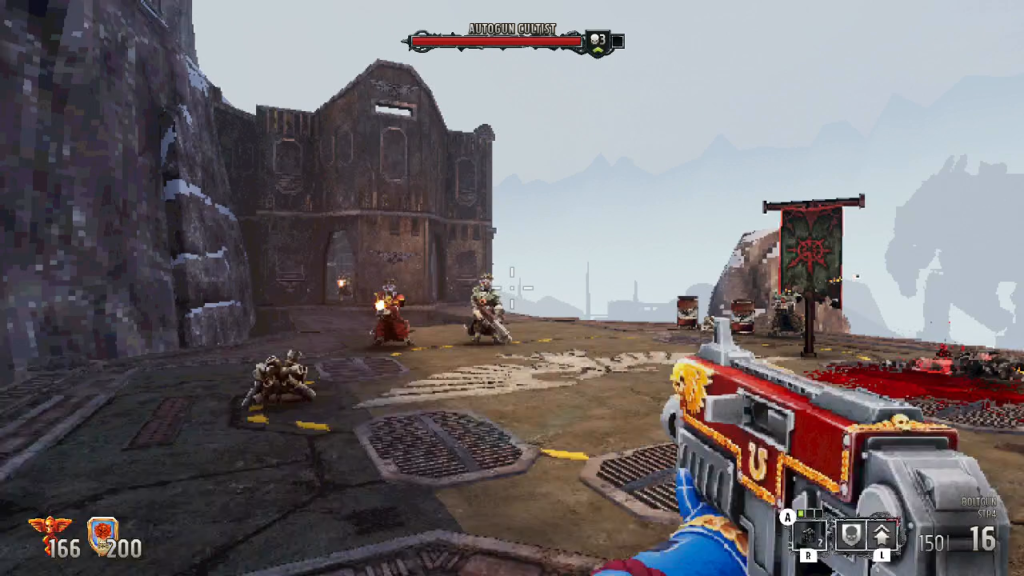
As a first-person shooter that deliberately models itself after the most iconic early installments in the genre, Boltgun focuses more on mastering familiar elements of design instead of reimagining them or creating all new ones. I guide the player character through a three-dimensional environment in search of colored keys that open color-coded doors. When all the doors have been opened, the exit is typically found and the player character moves onto the next level.
At almost every step along Malum’s quest through Graia, he is attacked by the planet’s inhabitants. Some of them are humans, or close enough, and attack Malum with firearms. Their projectiles move with almost comical slowness, allowing me to guide Malum out of their path long before they connect. Other enemies are melee focused and try to swarm the player character with sheer numbers. In either case, they are killed with the arsenal Malum carries on his body. Ammunition is technically limited, but is strewn across levels at quantities that would make the most paranoid prepper blush. Though I may temporarily exhaust one of Malum’s weapons of all its projectiles, using any of them again is never a long-term concern. A refill is always just around the next corner.
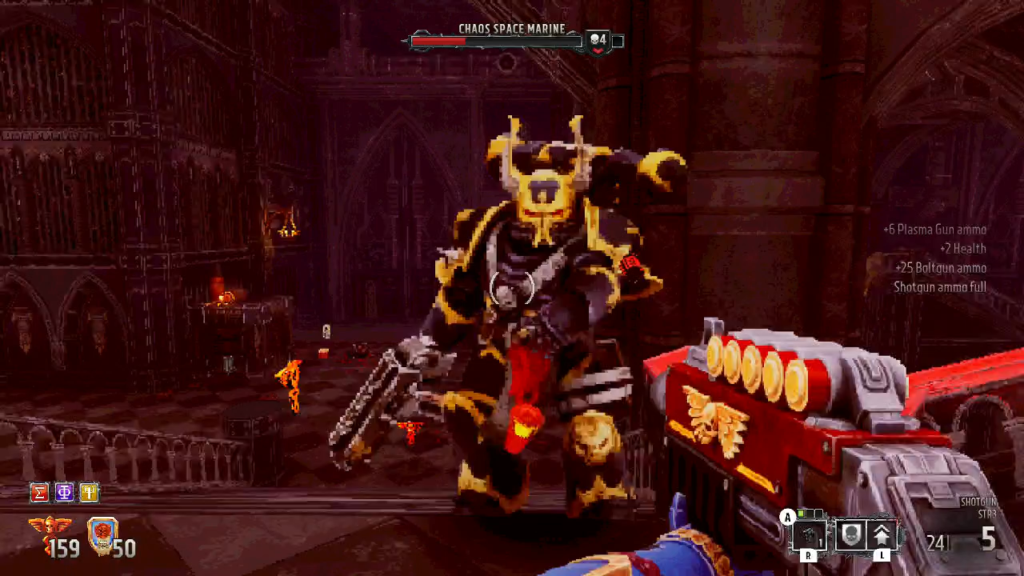
This reverence of design dogma isn’t to suggest that Boltgun is completely devoid of more contemporary ideas. I can freely direct Malum’s point of view—and more importantly, where he aims his weapon—in any direction. He can also jump and, when a platform is just out of reach, grab onto an edge to pull himself up. This allows levels some verticality without being ruled by ramps and staircases, though many will be thankful to hear that first-person jumping never goes all the way into notorious first-person platforming. If Malum does tumble down one of Graia’s few bottomless pits, he is transported right back where he fell with a small hit to his health total.
One idea that does feel truly transformative is Malum’s chainsaw sword. This fearsome weapon has a designated use button, letting Malum swing it at anything that enters melee range without having to put down his firearm. If I hold down this button, time freezes for a moment and nearby targets are highlighted in red. Releasing the button unleashes an empowered swing, which becomes still-more-powerful when additional button presses grind the blade’s chainsaw edge into the target’s flesh. This effect traps weaker enemies in place until they succumb fully to the damage. It also turns its victims into a pile of gore, a result especially useful against those who possess the power to resurrect.
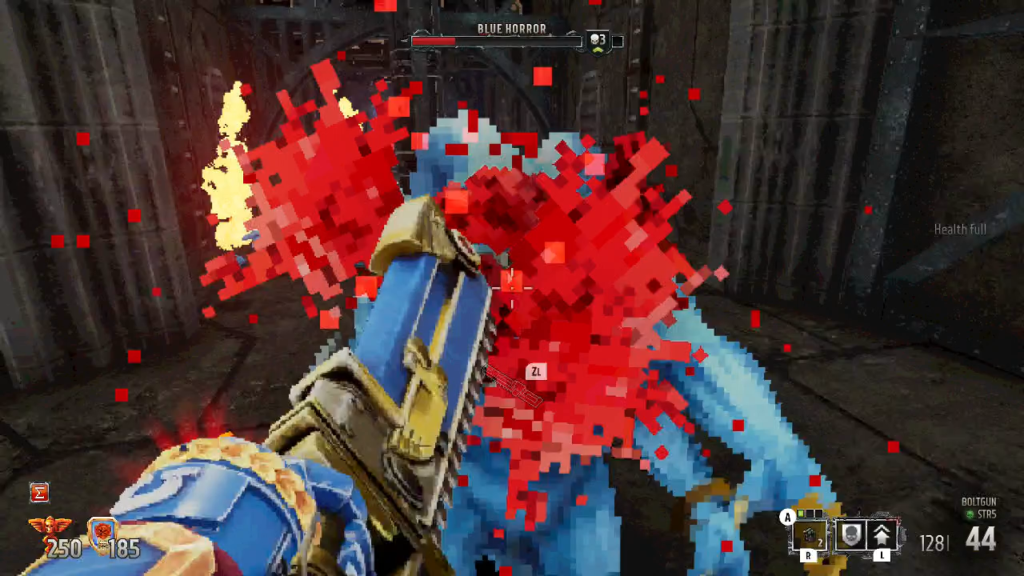
The first firearm Malum finds after staggering from his pod on Graius is the titular Boltgun. The decision to subtitle the videogame after this weapon is not hubristic. It’s a fantastic weapon. Most of the satisfaction I take from the experience comes from employing this weapon against the army of men, former men, and daemons that get in Malum’s way.
The Boltgun’s effectiveness is down to its simplicity. Its simplicity is in its name. The Boltgun fires heavy bolts, each accompanied by a loud and certain bang. Its simplicity is also in its application. With a tap of the controller’s trigger button, a single bolt is fired with perfect accuracy wherever I have pointed Malum’s on-screen crosshair. If the bolt misses, it’s not a result of its arc or Malum’s swaying grip. It’s because I didn’t aim well enough. The bolt’s path is pleasurably, improbably, and perfectly straight and plugging an Autogun Cultist in one shot from across a room never stops feeling good. Against larger groups, the trigger button may be held down, turning those perfect single shots into a measured spray. These are less accurate, but when large groups are clawing at Malum’s throat, quality becomes less of a concern than quantity.
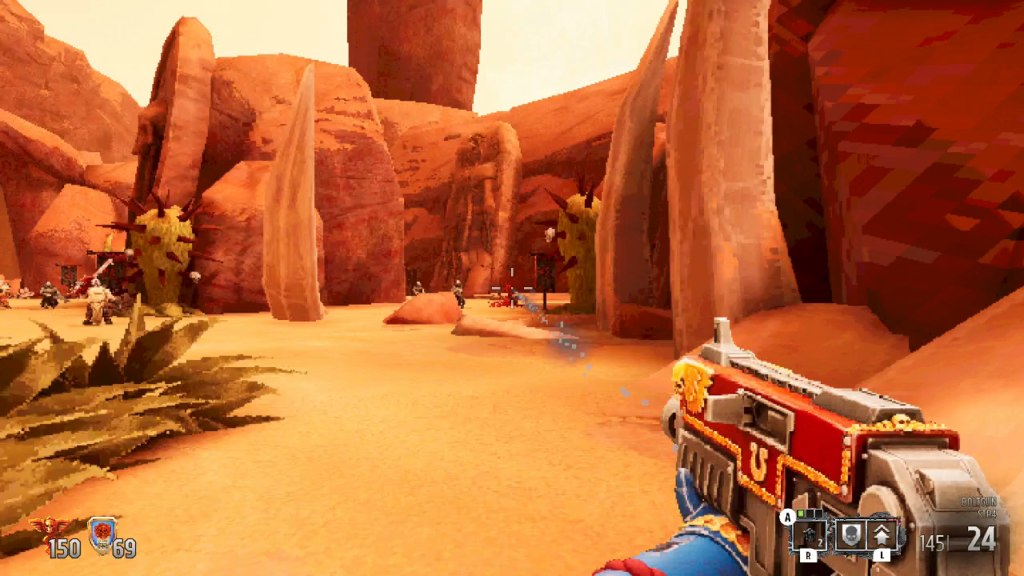
The Boltgun is not Malum’s most powerful weapon. It is his most effective. Against every enemy that appears on screen, my first thought is “do I use the Boltgun, or one of Malum’s seven other firearms?” The Boltgun is nearly always a safe choice. In the most iconic first-person shooters, there is one weapon which stands out due to its effectiveness against the player character’s enemies and the sheer joy experienced from its use. DOOM has the Shotgun. Halo has the Battle Rifle. Boltgun has the Boltgun.
With as satisfying and effective a weapon as the Boltgun may be, the videogame from which it takes its title is unremarkable as a first-person shooter. Any of its other features which makes it stand out among this crowded genre is purely aesthetic.
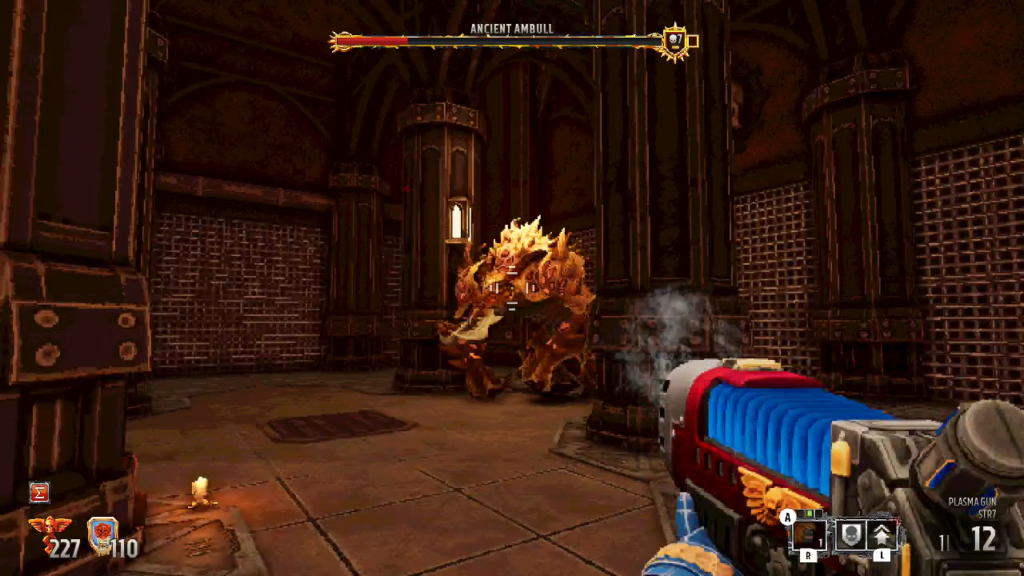
Looking at still images from Boltgun, I could almost believe it’s an old-fashioned first-person dungeon crawling RPG. It’s easy to go through large parts of each level only encountering traditional fantasy monsters. Slobbering brutes called Horrors snap at Malum with huge jaws full of nasty teeth. Tiny cackling goblins called Nurglings leap at Malum’s face and hammer his legs. Delicate and mysterious creatures called Flamers conjure bursts of fire with a wave of their arms.
This impression is reinforced by the interface. When the crosshair passes over an enemy, a red meter appears at the top of the screen representing their hit points alongside their name and a symbol showing the effectiveness of Malum’s currently equipped weapon. Green arrows mean the weapon will deal extra damage. Red arrows mean it will deal less. It’s not always obvious how much damage a weapon will deal to any given enemy. In a first-person shooter inspired by genre classics, it’s disconcerting to find that most enemies are resistant to the Shotgun. I used it the least of all Malum’s firearms.
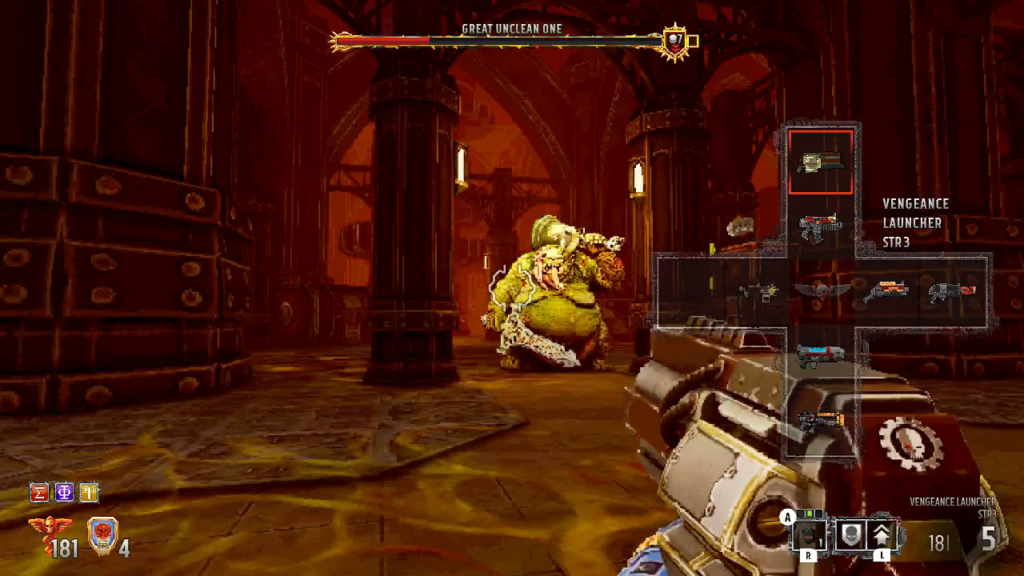
Taking all of these elements into consideration, for a moment I almost believe that the player character is standing on a square in a grid-based dungeon and I can take my time optimizing the situation before acting. But then the creature turns and charges at Malum and I remember that Boltgun is more DOOM than Eye of the Beholder. The sound of gunfire attracts every nearby man and monster and Malum is soon plunged into a protracted gunfight, ducking around corners for cover and using his superior mobility to gain the advantage over his enemies’ numbers.
This impression of Boltgun being a first-person dungeon crawler is reinforced by its graphics. It’s an ugly videogame, and I don’t mean that in a bad way. Despite the high definition resolution, every surface is decorated with low-resolution textures, creating an eyecatching lo-fi effect.
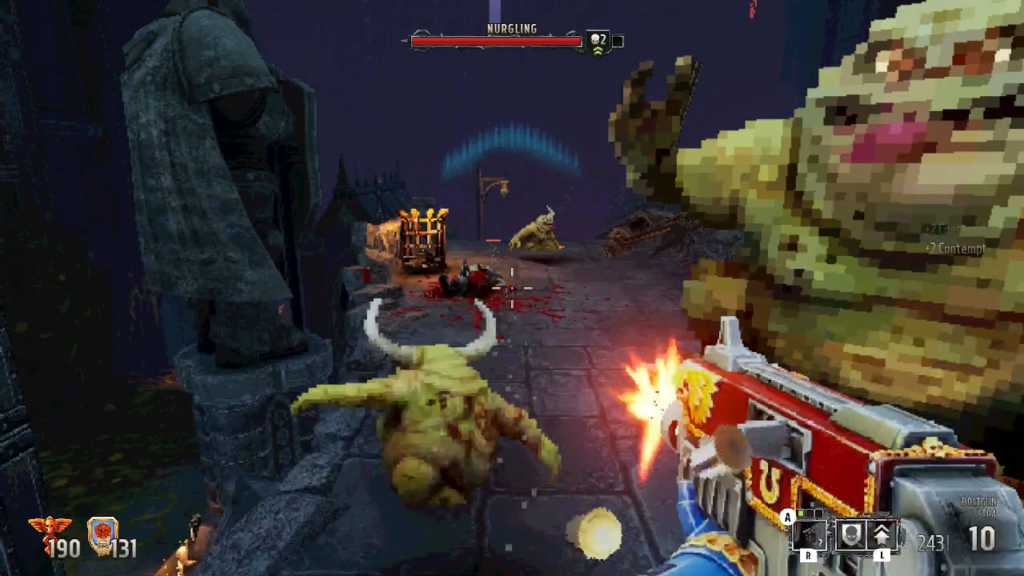
Enemy designs are pulled straight out of DOOM, existing as two-dimensional sprites in three-dimensional spaces that scale themselves up and down as they grow closer or further away from the player character. These creatures are likewise drawn with low-resolution pixel art. As daemons come close enough to attack Malum, every jagged edge of their body parts become visible and, if the action weren’t so frantic, I could count the individual pixels in many of their faces. The effect is enhanced by simple animations. Enemies move through space much faster than their limbs carry them, creating the impression they are sliding through the environment. In another videogame this would look like a graphical glitch. Here, it adds to the charming sense of deliberately limited and dated graphics.
Cutscenes are also reminiscent of early PC gaming classics. Animations are basic and continue to utilize lo-fi sprite art. Instead of moving the entire body, different elements of a character’s body shift up and down to create the illusion of life. Inquisitor Seibel gives Boltgun’s opening mission briefing. She is a foul creature, her scarred and pockmarked face covered by a breathing apparatus that gives her a deep, rasping voice and helpfully precludes the need to animate her mouth. To still suggest that she is a living being, the massive pauldrons on her shoulders slowly shift up and down. The effect is subtle but suggests the character is breathing. Add in the occasional blink of her eyes and through the smallest manipulations of a practically still image, an animated character comes alive.
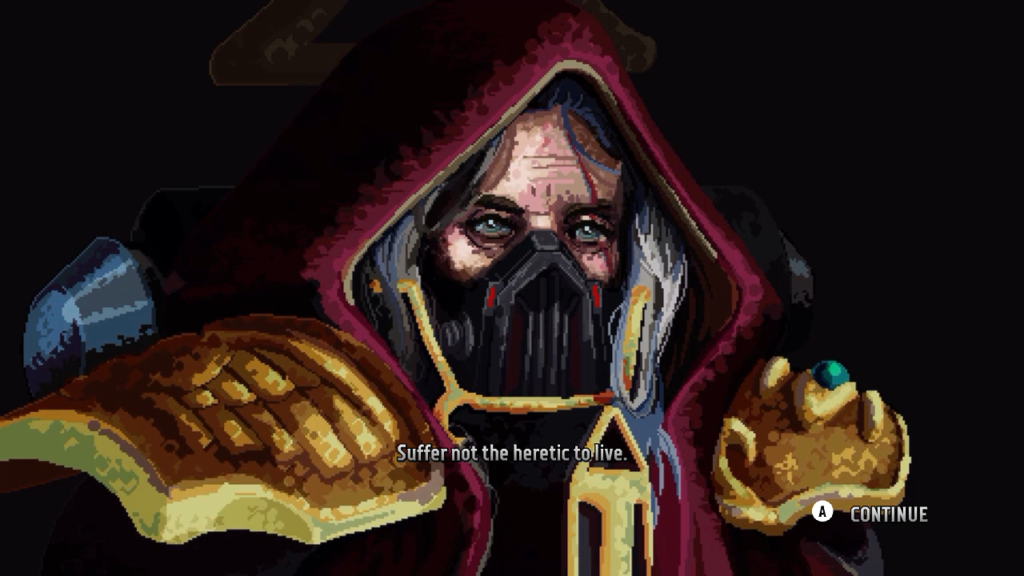
These crude graphics, both during cutscenes and when the videogame is in action, make Boltgun instantly memorable. I was drawn to play it solely from the graphics showcased in its trailers and promotional images, and I was not disappointed seeing them in action.
The final aesthetic flourish that makes Boltgun unique among the glut of first-person shooters is how it grounds me in its universe. This is my first foray into the Warhammer 40,000 setting, and while I do not understand every reference to all persons and events, I am still able to discern a few key details from choices in characterization and design.
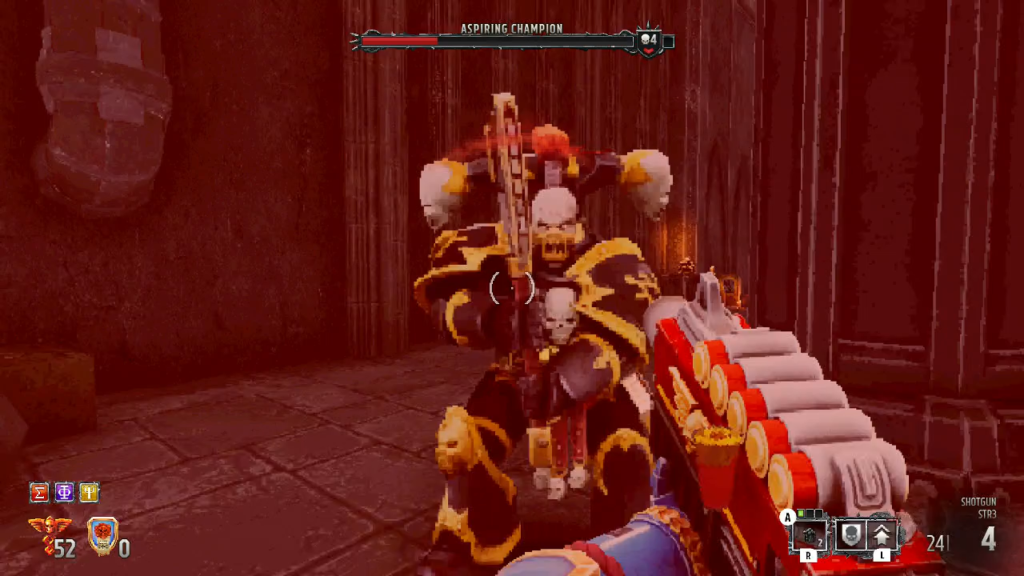
It is obvious that Malum Caedo is the protagonist. It is equally obvious that the Imperial Space Marines and the Inquisitors who dispatch them on missions are not the good guys. Inquisitor Seibel drips with sinister intention and her plans for the missing power source will doubtless end in disaster.
Malum is accompanied on his mission by Incommodus, a “servo skull,” a floating skull wearing a crown of flame. Incommodus is meant to guide Malum through Graius and point out caches of health and ammunition. Levels are straightforward enough and resources obvious enough that this is almost never useful. Incommodus is far more effective at characterizing the Imperium it serves, encouraging Malum to exterminate heretics while also noting that being exposed to heretics will result in excommunication. There is no good ending for Malum, but he is a loyal servant of the Imperium, and he perseveres despite Incommodus’ discouraging advice.
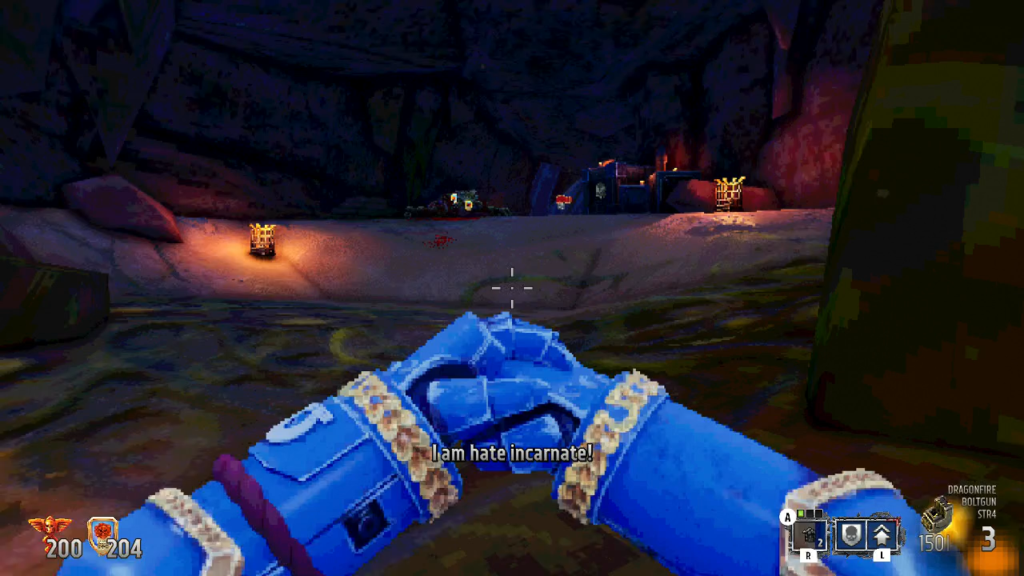
It is the specific details of Malum Caedo as a player character which give me the greatest insight into who and what the Space Marines are. I don’t get many opportunities to see the Space Marine’s power armor, but those glimpses show it is a perverse pastiche of knight’s armor by way of the Third Reich. It is bright blue, a typically heroic color, but its chest and joints are emblazoned with bombastic golden eagles and menacing skulls. The heavy armor makes Malum stomp with every footstep; if I could see his legs, I’m certain he would be goosestepping. The ultimate flourish of characterization is Malum’s dedicated taunt button. This serves no functional purpose in battle, but directing Malum to shout propaganda at his enemies gives me a chance to immerse myself more in his repugnant ideology.
All these elements taken as a whole render Malum into a parody of fascist soldier stereotypes. Despite the extremes this parody reaches, it’s played completely straight, which makes it all the more chilling. Malum channels every young boy’s uncultivated inner fascist into a simplistic imagining of warfare. Everyone on my side is sanctified, everyone not on my side is demonized. The Boltgun is the biggest glimpse into this disturbing worldview. It resembles a toy more than a deadly weapon, thick and emblazoned with more Imperial iconography, its bolts easily seen as darts from a nerf gun even as they splatter their targets into viscera. Beneath the Nazi space armor, the propaganda, and the firepower, Malum is a child playing pretend.
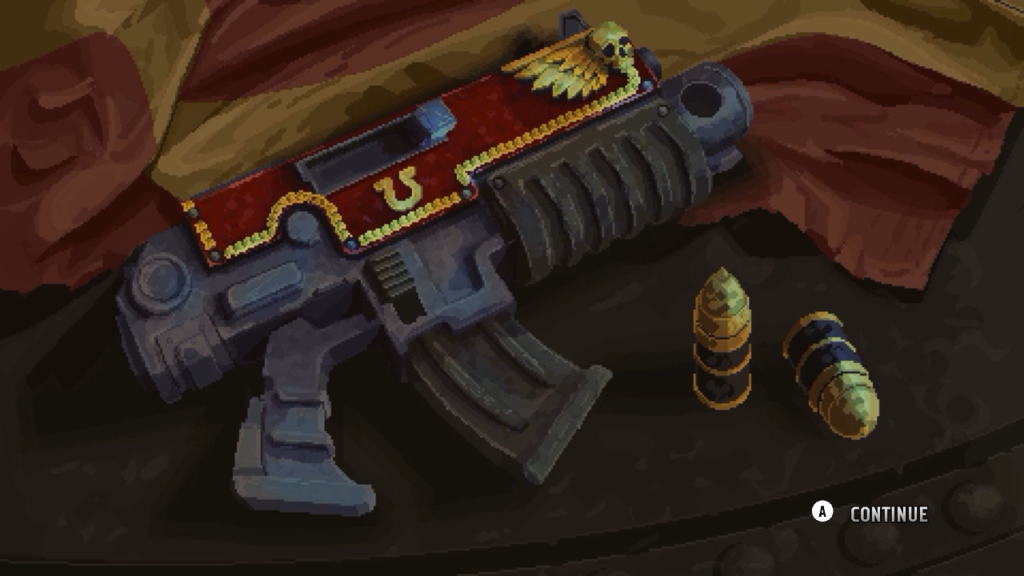
Warhammer 40,000: Boltgun has many strengths. It is first and foremost visually distinct. Its lo-fi graphics are what draws me to it, and they are what I will remember about the experience longest. The titular Boltgun is a satisfying weapon to use, operating well as both a weapon of precise skill and also mass destruction. It also does a great job immersing me in the culture of the Imperial Space Marines, a thoroughly unpleasant glimpse at a totalitarian worldview that would seem cartoonish if fascism and Nazis weren’t real things in our world. Despite these strengths, it is still a by-the-numbers first-person shooter. Come at Boltgun looking to enjoy its graphics, its theming, or the Boltgun itself, and you will have an interesting and memorable experience. Come at it looking to play something other than an average first-person shooter, and you may be disappointed.